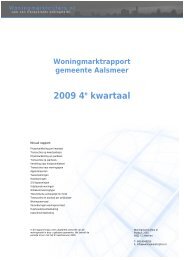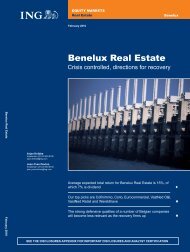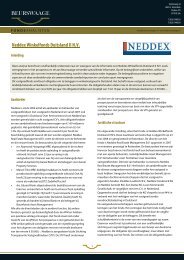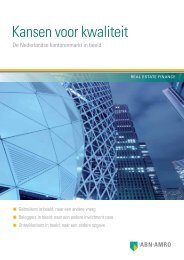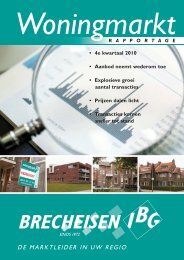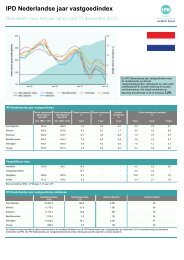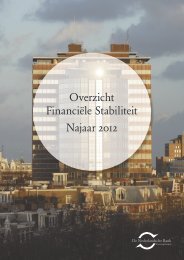Global Debt Sales survey 2012 - Vastgoedjournaal
Global Debt Sales survey 2012 - Vastgoedjournaal
Global Debt Sales survey 2012 - Vastgoedjournaal
You also want an ePaper? Increase the reach of your titles
YUMPU automatically turns print PDFs into web optimized ePapers that Google loves.
MARKET OVERVIEWBasel IIIIncreasing Tier 1 capital or decreasing RWAs?The key elements include:• increased capital ratios, with a focus on the need for good quality, loss-absorbing equity capital• increasing quality of capital requirements with a focus on harmonization across borders• new leverage requirements, effectively capping the absolute size of balance sheets in relation tocapital, irrespective of risk• new measures to improve counterparty risk management, focused on collateral managementand stress testing• new liquidity requirements to ensure firms hold sufficient high quality liquid assets to meetshort-term shocks, and to encourage a restructuring of the balance sheet with a focus onmatching of long-term funding sources against longer-term assets.With international capital markets effectively closed to new shareissuances and muted bank profitability, achieving the higher Tier 1 ratiothresholds will be assisted through RWA reduction. The conditions areripe for a considerable increase in the volume of deleveraging around theworld, but the urgency is greatest in Europe. Bank restructuring continuesapace and the deadline for banks to have a core Tier 1 capital ratio of 9percent under Basel III is fast approaching (see: Basel III: Increasing Tier 1capital or decreasing RWAs?, above). The International Monetary Fund’s(IMF) latest <strong>Global</strong> Financial Stability Report suggests that largeEU-based banks could shrink their combined balance sheet by as muchas US$2.6 trillion through end-2013, or almost 7 percent of total assets.“Our estimate is that about one-fourth of this deleveraging could occurthrough a reduction in lending, with the remainder coming largely fromsales of securities and non-core assets,” the IMF said. 2Achieving the targets of Basel III is by no means assured. Morgan Stanleyestimates that 11 of the 30 largest banks in Europe will not reach therequired 9 percent threshold by 2013, including Deutsche Bank, CreditAgricole, Unicredit and Lloyds Banking Group. 3 The bank noted that adeteriorating earnings outlook for European banks means that banks willhave more challenging organic capital builds to reach new capital ratios.“The European market has seen some notable transactions such asProject Isobel, in which the Royal Bank of Scotland reportedly sold a 25percent interest in a GBP1.36 billion portfolio of loans to Blackstone. Ina transaction that also closed in December 2011, Project Royal, LloydsBanking Group sold GBP900 million of non-performing loans to LoneStar. 4 But despite these headline-grabbing deals, the market has nottaken off to the extent that many participants expected,” says Stuart King,<strong>Global</strong> Co-Leader, KPMG’s Portfolio Solutions Group.2 IMF <strong>Global</strong> Financial Stability Report – The Quest forLasting Stability, April <strong>2012</strong>3 Morgan Stanley: European banks: What are the risksof €1.5-2.5trn deleveraging?, November 20114 CoStar News, December 7 2011, http://www.costar.co.uk/en/assets/news/2011/December/Lone-Star-wins-1bn-Project-Royal/© <strong>2012</strong> KPMG International Cooperative (“KPMG International”), a Swiss GLOBAL entity. DEBT SALES SURVEY <strong>2012</strong> 7



